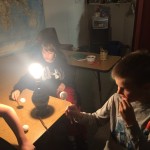

In 4th and 5th grades, students continue their study of flight by tackling Newton’s Laws of Motion. They’ve practiced demonstrating the laws with props in the science room. They’ve listened to songs, which now, they say ruefully, are “stuck” in their heads. That’s the idea! Now, to make these academic concepts more real, they’re working to spot examples of Newton’s Laws in their daily lives, especially in the sports they play and activities they enjoy. A 5th grader pointed out that rock climbing is a great example of an equal and opposite reaction, because “you pull down and move your body up.” Another suggested a hockey puck shows us how an object in motion stays in motion, while a 4th grader analyzed a karate chop’s force, mass, and acceleration. One class picked apart what happens when a drumstick hits a drum. Through these discussions, Bixby scientists are showing their understanding of Newton’s Laws and that they’re a very active, involved bunch!
Soon, to conclude our unit on flight, students will build and fly paper airplanes, relying on what they’ve learned about forces and motion. They’ll answer questions about their designs. This culminating project allows students to show what they’ve learned and to address areas where they may have lingering confusion. In November, they’ll begin their next undertaking in science: exploring human body’s systems.


